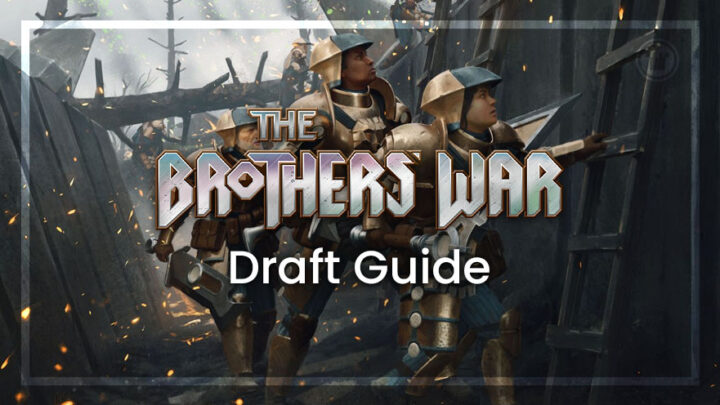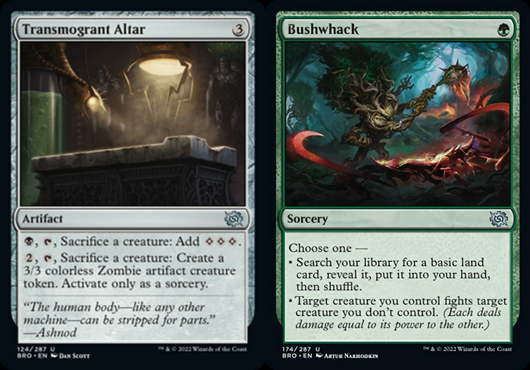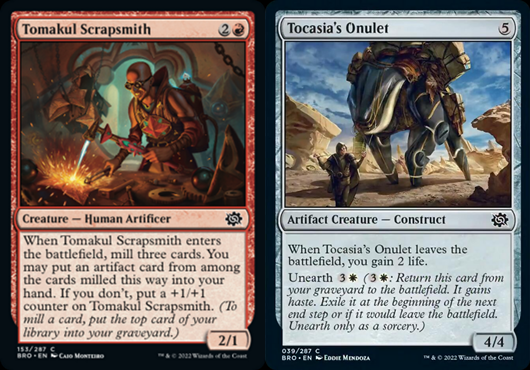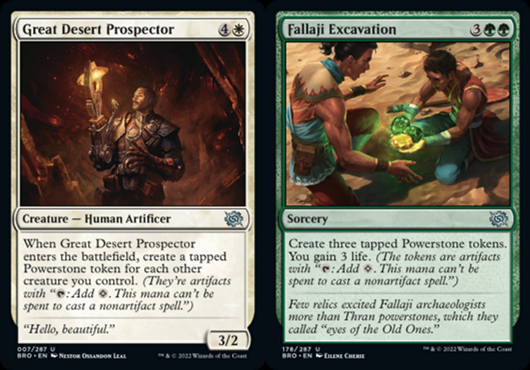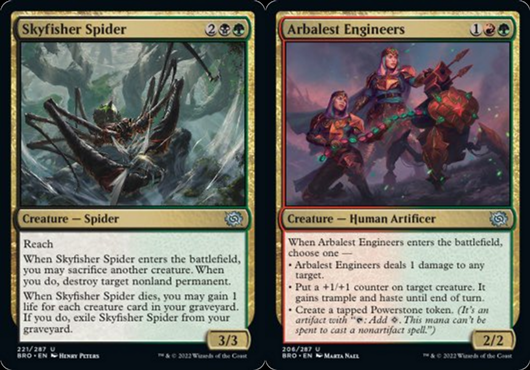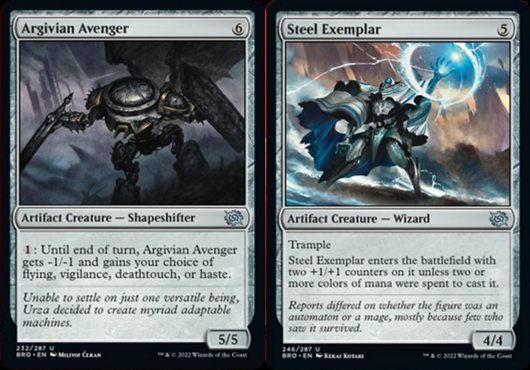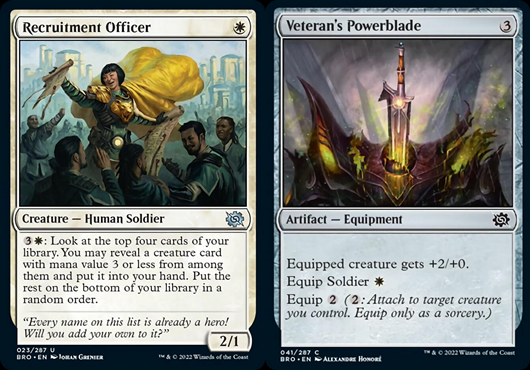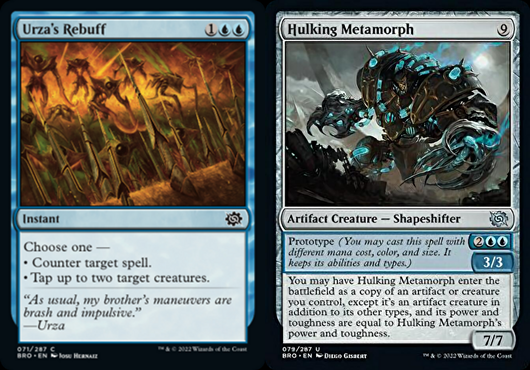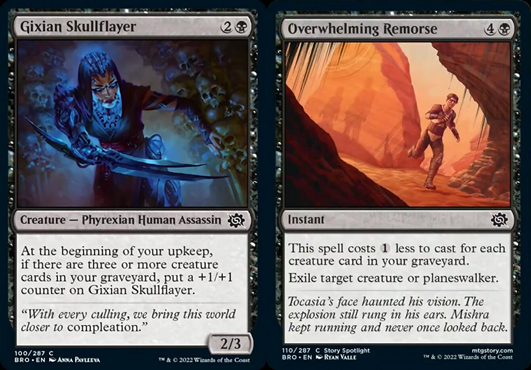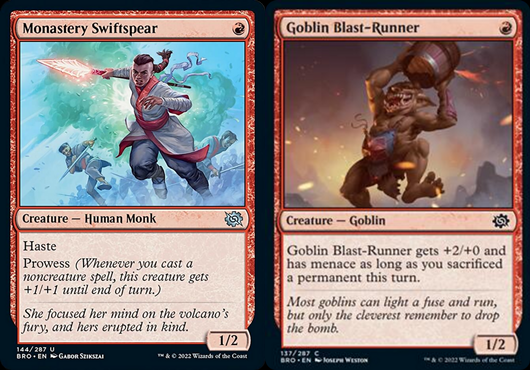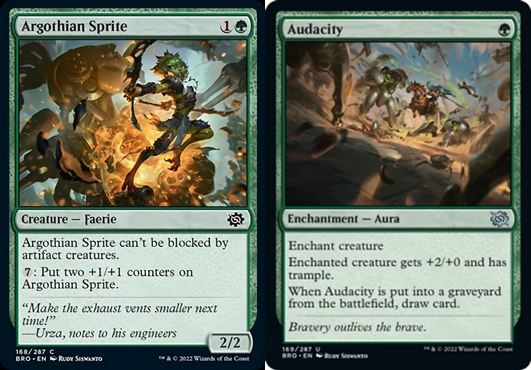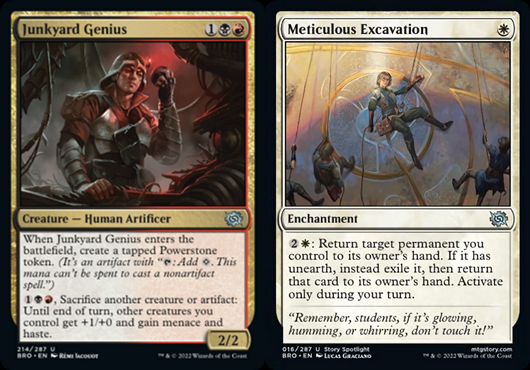With The Brothers’ War returning to a traditional, simultaneous Arena and physical release schedule, Draft lovers get to spend a little more time with the full spoiler before jumping into the trenches.
That’s just as well, since this set is very unique in many fundamental aspects. Wizards has leaned into the epic, world-spanning scale of their story. Every color is going big in Limited, and I mean REALLY big.
To help you avoid being shell-shocked in your first few draft runs, I’ve prepared a quick run-down of the major themes and concerns apparent in the set spoiler. Wrap your head around it now and you’ll be the one bringing the war to your opponent’s doors on release day!
SHAPE OF THE SET
As always, our gameplanning starts with a top-down attempt to understand what makes The Brothers’ War unique from a Limited perspective. What are the central themes every color interacts with? What is the balance between threats and removal? How quickly should you expect games to reach a climax?
A lot of the attention during spoiler season goes to the flashy rares and mythics, but for our purposes, the commons and uncommons are what matter most. These are the cards you’ll have the opportunity to pick in most if not all your drafts, so you can actually plan to rely on their effects. And there are some very powerful effects on the table in The Brothers’ War.
As you might expect from a set modeling itself on Antiquities, the main mechanical theme here is… mechanics (like, the giant flying battle suits and clockwork soldier kind of mechanics). Artifacts and artifact creatures make up a huge portion of the cards in the set. And aside from influencing color distribution (which we’ll get to later), there are plenty of artifact-synergy spells in all colors. I’m confident every single Brothers’ War draft deck will contain multiple artifacts, so have them in mind from the first pick.
POWER FROM THE PAST
We’ve had artifact-heavy draft sets before, usually on planes like Mirrodin or Kaladesh where machines are part of everyday life. But in this setting, the primary source of artifice is archaeology, as Urza and Mishra dig for the technology of ancient, Thran civilizations.
In gameplay terms, this translates to a lot of self-milling and graveyard recursion, often with the appropriately-named Unearth mechanic. Every color gets in on the reanimation party this time, so make sure you take graveyard-hate more highly than usual — even in best of one. There’s also lots of the usual “return to hand” recursion, so expect some very long and grindy games!
The most important artifacts our titular brothers are warring over are Powerstones: mysterious crystals which contain the energy needed to fuel robotic armies. Rather than represent these omnipresent artifacts with more than one specific card, Wizards of the Coast have instead made them a signature noncreature token for the set — like Blood, Food and Clues before them.
All colors can produce Powerstone tokens, and at a much higher rate than I’d expected. That means you should definitely consider how your deck will utilize their mana from the outset of the draft, so you don’t feel like you’re wasting the value of these cards later on.
Remember, the mana isn’t just usable for big artifact spells. It can also pay for the cost of activated or triggered abilities — even on non-artifact cards.
There are plenty of big costs in the set, and I’m definitely rating them higher than usual thanks to this powerful and universal ramp. This also means any spell that unconditionally removes (or saves) a creature is more valuable than ever, as they’ll scale all the way up to whatever 7+ mana titans your opponents are deploying.
MAKE MINE MONOCHROME
In other draft guide articles, this would be the section where I lay out the different two-color deck archetypes and their key mechanics, as exemplified by their “signpost” gold uncommon cards. While we do still have those 10 gold uncommons, you’ll notice they’re much less… signpost-y than usual. Most of them read as just solid value plays.
That’s because The Brothers’ War doesn’t really seem too attached to the idea of two-color draft archetypes as the norm. The huge number of colorless artifact spells — 46 at common and uncommon across the set — means there are both fewer incentives to go outside your main color and more cards you can draft without doing so.
That’s not to say that you can’t or shouldn’t play two colors, and there’s some respectable fixing to help you do it. But it’s not the baseline expectation, as it would be for most Limited environments these days.
The design team has made sure every color has access to the fundamental tools of ramp, removal and recursion, all at common, so I’m approaching each color as a possible archetype on its own this time.
White
White has a stronger graveyard theme than usual, albeit attached to a lot of the same small creatures and sorcery-speed removal we’re used to from this color. Much of its recursion is specialized toward returning these same cheap permanents, which does raise concerns when you see how large the scale of everything else can get.
Common pump effects, such as Veteran’s Powerblade, Military Discipline and Ambush Paratrooper, are crucial for helping the small stuff trade up so you can maintain pressure and have payoffs for recursion spells like Recommission.
The Paratrooper is also representative of how White aims to use its Powerstone tokens: powerful mana-sink activated effects rather than just bigger spells. White also has Disenchant, which might unironically be the second best removal spell in the set.
Blue
Just like in Dominaria United, blue pairs a suite of creatures that grow over time with a multitude of spells to slow an opponent down. Whether you try using these tools to run a sprint or a marathon depends on personal preference and what you get out of your second color.
It is worth mentioning that despite the blue/white uncommon focusing on Soldiers, you probably won’t see enough of that type to build around unless you can add red, too.
There seem to be slightly fewer interactive instants than we’d usually see out of the classic control color, but Scatter Ray, Machine Over Matter and Urza’s Rebuff might be all you ever need. The suite of creature threats seems very powerful, with many cards capable of a short clock without much help.
Take Flight is a very expensive Curiosity, but not needing the enchanted creature to actually connect (or have its own evasion) helps the cost seem a bit more justified.
Black
In a set where every color gets to have a go at graveyard stuff, black simply doubles down on its usual hijinks. Black actually has both Unearth/Raise Dead effects and spells that scale with the number of creature cards in your graveyard, so there’s an obvious tension drafters will have to navigate. But the power on offer is well worth it, with some format-defining removal and solid threats which can dominate a long game.
All the slow-growing creatures and powerful interaction makes black a very nice compliment for blue, even if red may offer superior sacrifice synergies. There are only four on-demand sacrifice outlets in the set, and half of them require red mana to cast.
Your level of reliance on that mechanic might push you into red some drafts. Black also seems to lack for good mana-sinks, so it will be tougher to find a use for those Powerstones without secondary colors.
Red
Here’s a big shock for you — red decks are once again set up to be fast and recklessly aggressive. Oh, and here’s a big Fling for you as well.
Pyrrhic Blast is definitely going to end some games with how large the artifact creatures get in the format, but red does have an impressively deep range of burn spells and combat tricks to get over the line. You can lean toward more Prowess or sacrifice synergies depending on your secondary color, any of which will help make up for the smaller size of many red creatures.
These effects can only go so far, though, and any non-burn late game is going to need to come from artifacts or a second color. Pay attention to your early drops and make that early pressure count!
Green
Normally green’s schtick in Limited is to go bigger than everybody else, with a sturdy and even curve of vanilla beaters which can trample through or fight down enemy armies. But in The Brothers’ War, everybody gets to ramp.
So, as a surprise twist, green ends up being much more of an aggro deck, with perhaps the most insanely powerful suite of pump spells and auras I’ve seen in a single set. Play this color and it’s time to double up your clock.
With much of the unconditional removal a bit more expensive, there’s less chance to be blown out for trying to pump up your one and two drops here — and I’m excited to see how these fast green decks perform.
In fact, you’re the most likely color to be sniping opposing threats for cheap. The fight spells on offer are also excellent, if sorcery speed. Green’s usual artifact-smashing theme was pared back to balance it in this very mechanized set, so make sure you get your hands on this removal ASAP.
Of course, you do also have the usual, big-mana bombs you’d expect in this color, and there’s quite a few ways to ramp into them. I just wouldn’t automatically assume you can out-bulk other colors when they all have their own fleet of jumbo robots to call on. Better to run another Argothian Sprite or Alloy Animist and throw your surplus mana into those, should it come to that.
EVERYTHING OLD IS NEW AGAIN
After taking stock of The Brothers War as a whole, I am once again floored by how Wizards continues to throw out novel twists on their winning Limited formula. Even in a set dedicated to one of the all-time classic themes, utilizing previously-seen mechanics and based heavily on Magic’s oldest reference material, we get a format that feels singular and enticing.
Maybe it’s just that I love slow, grindy gameplay and permanent-based value engines — but I’m more excited for this draft set than I have been for any since Guilds of Ravnica. The presence of so many artifact cards changing the math on how many colors you run feels like it will be a great signature twist, and I’m interested to see whether it leads to as many mono-color drafts as I’ve predicted.
I wish you the best of luck in your early Limited games. Feel free to let me know how you find the set (and whether my advice was any good) over on Twitter. Otherwise, I’ll see you at the next set release!

Tom’s fate was sealed in 7th grade when his friend lent him a pile of commons to play Magic. He quickly picked up Boros and Orzhov decks in Ravnica block and has remained a staunch white magician ever since. A fan of all Constructed formats, he enjoys studying the history of the tournament meta. He specializes in midrange decks, especially Death & Taxes and Martyr Proc. One day, he swears he will win an MCQ with Evershrike. Ask him how at @AWanderingBard, or watch him stream Magic at twitch.tv/TheWanderingBard.

